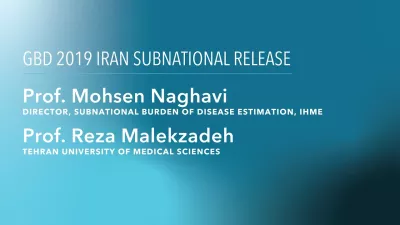GBD 2019 | Burden of disease in Iran
Published April 6, 2022

This transcript has been lightly edited for clarity.
Prof. Mohsen Naghavi:
We started subnational estimation for Iran in 2018. And this paper that you are seeing is the result of the three years work on this area that has happened between 800 researchers and scientists in Iran and in the Institute of Health Metrics and Evaluation in the University of Washington.
And this paper is the most comprehensive and evidence-based that explains the situation of the health in Iran by all the provinces and each province, one by one, by age, by sex. And we put together, we check with more than 800 collaborators that we have in Iran, scientists and researchers and people working in the Ministry of Health. We checked, and when we agreed that the result is correct, based on the evidence, based on the method, we put together in this paper.
In this paper, we tried to show that each province, what is the situation in each province. Which disease makes more burden in some province and lower burden in others. And this is the first time that we will publish in the world burden of disease, effect of burden of disease by province, effect on the life expectancy.
Prof. Reza Malekzadeh:
One of the major findings of this study is the increase in life expectancy at birth in the Iranian population. And this, of course, has been increasing during the last 40 years, but especially during the last 20 years, it has increased more than ten years of life expectancy of all Iranians, and especially the life expectancy increased in women. The life expectancy at birth in women is now close to 80 years - 79.6, while in men it is about 76.1. And also this life expectancy has increased all over the country in all provinces, and the disparity between provinces has declined, especially during the last 20 years.
This is evidence for really improving the health status and health care overall in Iran. One of the major reasons for this increase is actually the control of infectious disease and decreasing the death rate in neonatal infants and also the mothers.
The other one is the improvement in injuries. We had a very high rate of injuries in the past and it has declined, especially the car accident which is still a major problem, but it has declined during the last 20 years.
Prof. Mohsen Naghavi:
Iran has a very good and important primary health care system, especially in the rural areas that came from the WHO in 1976, based on all of the experience that started in the 1970s and 1960s in northwest Iran and then expanded. Around 2000, 2010 we had a very important result for this primary health system in the rural areas, especially in the rural areas. Now, for some indicators we have much better than urban areas in Iran.
We have integration between medical education and health system that is not usual in the other countries.
Prof. Reza Malekzadeh:
One major problem is that the pattern of disease has changed from the infectious disease to non-communicable disease. That is mainly due to the risk factors like overeating, obesity, hypertension, hyperlipidemia, diabetes, that has become very common in Iran.
Therefore, the major challenge in the future is to control non-communicable disease. The most common cause of death is actually the myocardial infarction, and other studies during the last ten years have shown that we can easily control these NCDs if we have a plan for it.
One major problem in Iran in the past is gender inequality, and during the last 40 years, especially during the last 20 years, the gender disparity has declined dramatically. Even in medical schools we have more female students than male students at present time in Iran, and the opportunity for females to be more active and also to have much better health status in Iran is now improving and almost there is no disparity. If anything, it's mainly for male not female in the health.
As is very well clear in this paper, one of the major developments in our health care system is the improvement of child and maternal health, and dramatic decline in the neonatal infant and five-year child mortality, and also very good care for the mothers. Even in rural areas, we now have very well developed health care. We call it health network, health houses for almost every village, close to 100% of the country for remote rural area. Also we have a special system for care of the mothers for delivery, and these are small units even in village which provide care for females in rural areas.
Prof. Mohsen Naghavi:
We opened the window for all Iranian researchers, scientists to use the results of the global burden of disease by province in Iran from 1990 until 2019, and soon we will publish from 1990 to 2020. I hope that this paper can help Ministry of Health, health workers and scientists in Iran for improving the public health in Iran.